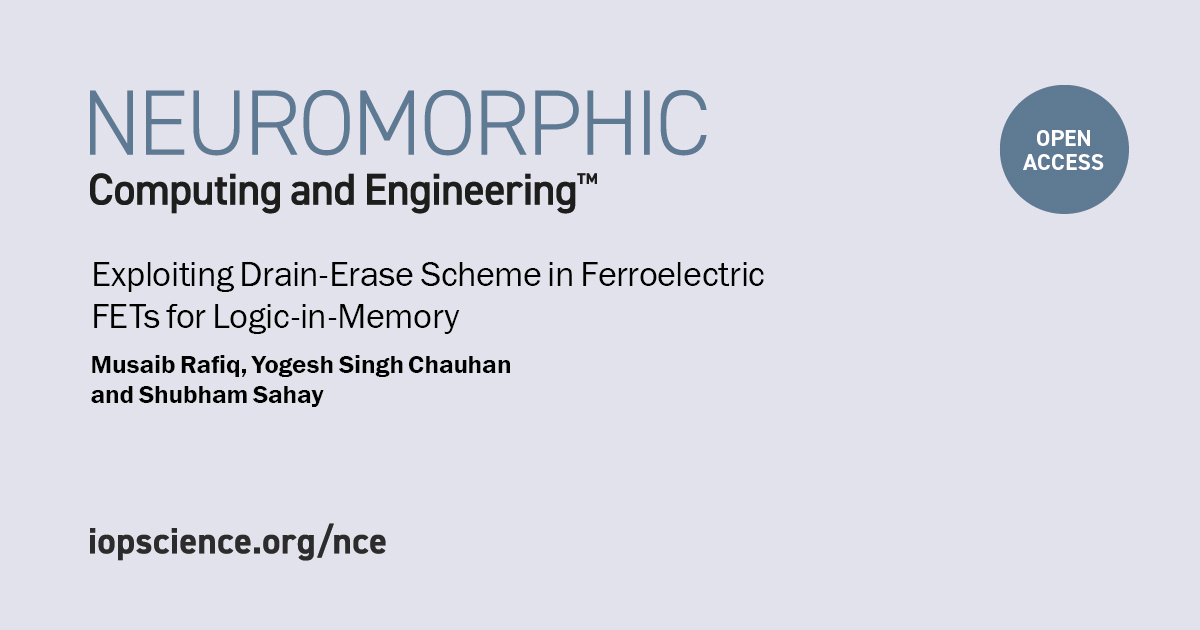
Neuromorphic Computing and Engineering
@iopneuromorphic
Get the latest #Neuromorphic Research, Publishing Tips, News, And Offers conveniently delivered to your inbox.
👉 Sign-up today: ow.ly/ABP450KFkmn
ID: 1333372622596431872
https://iopscience.org/nce 30-11-2020 11:30:07
542 Tweet
2,2K Takipçi
2,2K Takip Edilen


Researchers from University of Groningen, TU Ilmenau, Forschungszentrum Jülich | @[email protected], University of Zurich, ETH Zurich, Tsinghua University, Universität Kiel CAU 🎓 have collaborated on a single-shot weight learning scheme to embed robust multi-timescale dynamics into attractor-based recurrent spiking neural networks: iopscience.iop.org/article/10.108…


Part of iopscience.iop.org/journal/2634-4…, this Perspective article from Jiyong Woo (경북대학교) and colleagues investigates gate-controlled ion-transport primarily in electrolytes for electrochemical random-access memory (ECRAM) for three-terminal synaptic devices: iopscience.iop.org/article/10.108…



Researchers from JKU - Johannes Kepler Universität Linz provide a mathematical framework that shows that the information encoding mechanisms of Threshold-Based Representation based on LIF and Send-on-Delta distinguish by maximal sparsity while meeting certain approximation conditions. iopscience.iop.org/article/10.108…



Sofie J Studholme, Joshua B Mallinson, Jamie K Steel & Simon Brown (University of Canterbury) demonstrate a route to experimental implementation of an integer factorization algorithm in percolating networks of nanoparticles (PNNs), which have a brain-like network structure: iopscience.iop.org/article/10.108…


As part of iopscience.iop.org/journal/2634-4…, Luis F. Herbozo C., Zhaojing Huang, Omid Kavehei & colleagues from University of Sydney investigate biologically plausible algorithms, specifically emphasizing time-domain inputs with low computational overhead, to monitor EEG signals: iopscience.iop.org/article/10.108…


Lei Deng (Tsinghua University) is our latest Rising Star. With colleagues at Center for Brain Inspired Computing Research THU and Taiyuan University of Technology he explores the emulation of finite state machines (FSMs) with neural networks, proposing discrete-time spiking recurrent neural networks iopscience.iop.org/article/10.108…


Part of iopscience.iop.org/collections/nc…, this paper from University of Groningen proposes Fused-MemBrain, inspired by Golgi's theory modeling the brain as a syncytial continuum, with a memristive network interfaced with spiking neural networks. Read more at: iopscience.iop.org/article/10.108…


Part of iopscience.iop.org/collections/nc…, this paper from Cristian Axenie and TH Nürnberg colleagues proposes a novel neuromorphic edge fusion of SNNs and event-based expectation maximization for the detection and tracking of pedestrians and cyclists. Read more at: iopscience.iop.org/article/10.108…


#TUBraunschweig researchers with colleagues at ams OSRAM & elsewhere in Germany and Switzerland present a novel approach for the implementation of a mixed photonic/electronic neural network using gallium nitride based microLEDs as an efficient key element iopscience.iop.org/article/10.108…


Our latest Rising Star is Chiara De Luca (Institute of Neuroinformatics, @uzh_en @eth_en), who with Filippo Costa proposes an encoding framework inspired by biological principles, using at most one spike per neuron, for low-power, low-latency processing: iopscience.iop.org/article/10.108…


Part of iopscience.iop.org/collections/nc…, this paper from TU München presents a novel spiking neuron model for signal processing of frequency-modulated continuous wave radars that outperforms the state-of-the-art spectrum analysis algorithms in many respects iopscience.iop.org/article/10.108…



Part of iopscience.iop.org/collections/nc…, here Mattias Borg and colleagues from Lund University and @ericssonlabs evaluate the viability of FTJ memristors as compute units for analog in-memory computing (AIMC), revealing benefits alongside intrinsic challenges: iopscience.iop.org/article/10.108…


Part of iopscience.iop.org/collections/nc…, this paper from IIT Kanpur proposes a novel, highly scalable, compact, energy-efficient, and reconfigurable logic-in-memory implementation by exploiting the drain-erase scheme utilizing a single ferroelectric FDSOI FET. iopscience.iop.org/article/10.108…


Part of iopscience.iop.org/collections/nc…, this Perspective article from Western Sydney University, University of Hertfordshire and CU Boulder 🦬 takes a look at machine olfaction, finding that applying neuromorphic principles may improve response time and task performance in robotic olfaction: iopscience.iop.org/article/10.108…


Our latest Rising Star is Suma George Cardwell, who with colleagues at Sandia National Labs presents work that aims to incorporate dendrites for "compute-on-wire" in neuromorphic architectures. Read the paper at iopscience.iop.org/article/10.108…, see the whole collection at iopscience.iop.org/collections/nc…


Researchers from National Technical University of Athens fabricated a free memory forming device consisting of a MoS2 monolayer with dimensions of ∼100 μm, decorated with ∼3 nm diameter Pt nanoparticles, demonstrating synaptic plasticity and neuronal coding schemes in experiments. iopscience.iop.org/article/10.108…



